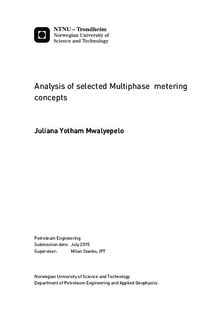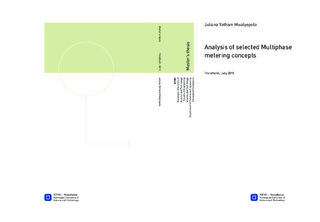| dc.description.abstract | This thesis work aimed at evaluating existing choke models that are used in oil and gas industry and thereafter to develop a new choke model for predicting mass flow rate through restrictions. Evaluation of the existing model was done by using flow rate data provided by Schüller papers of 2003 and 2006. Individual data sets were simulated in HYSYS to get thermodynamics properties of the fluids to be used as inputs in the models. Only three existing choke models were selected for model evaluation i.e. Sachdeva, et al., 1986, Perkins, 1993 and Al-Safran, et al., 2007 models.
The three selected models were programmed in Excel using Visual Basic for Applications (VBA) and error analysis of each model was performed using three evaluation criteria i.e. average relative error, average absolute and standard deviation.
From the evaluation performed using Schüller data, Sachdeva, et al., 1986 model was found to have average relative error of 1.76%, average absolute error of 10.52% and standard deviation of 12.49%. Perkins, 1993 model gave an average relative error of -24.17%, average absolute error of 30.74% and standard deviation of 25.91%. Al-Safran, et al., 2007 model exihibited an average relative error of -10.10%, absolute error of 17.48% and standard deviation of 17.6%.
Based on the evaluation results Sachdeva model was found to be the best model for predicting mass flow rate through restriction. Sachdeva model was therefore modified and improved by introducing a slippgae factor. Error analysis of the modified Sachdeva model showed an average relative error of -0.4%, average absolute error of 6.12% and standard deviation of 7.66%. The modified Sachdeva model was calibrated using the concept of discharge coefficient (CD) and the best value of CD for model calibration was found to be 0.65.
The new choke model is proposed based on the model developed by Sachdeva, et al., 1986. The model improves the predictability considerably by reducing half the deviation from the original Sachdeva model, all the prediction seem to be within the range of 10% accurancy. However, it is recommended to evaluate the new model using more experimental data.
From the evaluation results of this thesis work it can be seen that different experimental data yields different evaluation results for the same model, Sachdeva, et al., 1986 evaluated his model using Pilehvari, 1980 and Ashford, 1974 data and obtained a standard deviation of 10.8% for Pilehvari critical data while Ashford data exihibited standard deviation of 13.8%. The same Sachdeva model showed a standard deviation of 12.49% when evaluated by using Schüller data.
Lastly the findings from this work recommend that more experimental data should be added for model evaluation in order to authenticate the accuracy of the model. It also recommends that data from other researchers who have done experiments on multiphase flow through chokes should be used to test the model. | |

